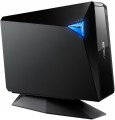Type
—
External. A drive designed to be connected as an external device. Such drives have a USB or eSATA interface (see "Connection") and are designed for frequent connection and disconnection. They are useful for laptops that do not have their own built-in drive, and for desktop PCs if there is no room in the case for installing an additional drive, or it needs to be connected to different computers.
—
External slim. The compact version of the external drive (see above) — these models have a much thinner thickness, which makes them especially convenient when transporting, for example, in a laptop bag.
—
Internal. Drives designed for installation in desktop PC cases, in 5.25" slots. They are installed as a permanently functioning part of the system and do not require frequent reconnection. The connection is made via the IDE or SATA interface (see "Connection").
—
Internal slim. A kind of internal drives (see above), designed for installation in laptops, where full-sized internal drives simply do not fit due to size. They differ in more compact dimensions (first of all, in thickness) and in the loading mechanism (for more details, see "Disk loading mechanism").
Interface
Type of connection of the drive to the computer.
— IDE. Standard for connecting internal (see "Type") optical drives. Provides data transfer rates up to 1 Gbps and allows you to connect up to three devices per loop (two full-function and one read-only). For a long time it was the main one for PCs, but today it is considered obsolete and is being replaced by the faster and more reliable SATA.
—
SATA. The most common modern standard for connecting internal (see "Type") drives; replaced IDE, it has a higher data exchange rate (up to 5.9 Gbps, depending on the version) and resistance to interference, but does not allow connecting more than one device per loop.
—
USB 2.0. The most common modern standard for connecting various external peripherals to a PC, including and optical drives. The vast majority of PCs and laptops are equipped with USB ports, due to which external drives with this interface are the most versatile today. Version 2.0 provides data transfer rates up to 480 Mbps.
—
USB 3.2 gen1. A version of the standard that provides data transfer rates up to 5 Gbps. Previously labeled as USB 3.1 gen1 and USB 3.0.
eSATA. A type of SATA interface designed to connect external (e — external) drives. Not compatible with regular SATA. The data transfer rate is up to 2.4 Gbps, which is significantly higher than that of USB 2.0 (a
...nd 3.0 appeared significantly later), but the interface itself is less versatile and, as a result, much less common.Vertical mount
A variety of external (see "Type") drives for which
operation in a vertical position is allowed. With this installation, they take up less space on the desktop and can significantly save space. At the same time, it is possible to work in a horizontal position.
